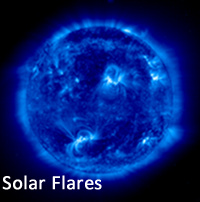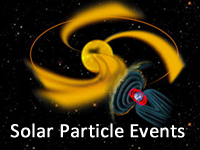
| {column0} |
| {column0} |
Solar flares, Coronal Mass Ejections (CMEs), and Solar particle events are the three main solar drivers of space weather.
 Solar Flares are huge explosions on the Sun. A flare appears as a sudden, intense brightening region on the Sun, typically lasting several minutes to hours. Flares are seen as bright areas on the Sun in x-rays, optical wavelengths and as bursts of noise in radio wavelengths. The primary energy of flares is the release of energy stored in strong magnetic fields. The electromagnetic
emission produced during flares travels at the speed of light, taking about 8 minutes to reach Earth—rapidly affecting the dayside of Earth.
Solar Flares are huge explosions on the Sun. A flare appears as a sudden, intense brightening region on the Sun, typically lasting several minutes to hours. Flares are seen as bright areas on the Sun in x-rays, optical wavelengths and as bursts of noise in radio wavelengths. The primary energy of flares is the release of energy stored in strong magnetic fields. The electromagnetic
emission produced during flares travels at the speed of light, taking about 8 minutes to reach Earth—rapidly affecting the dayside of Earth.
 Coronal Mass Ejections are explosive outbursts of plasma from the Sun’s outer atmosphere, the Corona. The blast of a CME typically carries roughly a billion tons of material outward from the Sun at speeds as fast as thousands of kilometers per second. A CME contains hot plasma (mostly protons and electrons) and powerful magnetic fields. In contrast to solar flares, CMEs are not particularly bright, may take hours to fully erupt from the Sun, and typically take 1-4 days to travel to Earth (but the fastest can arrive in under a day).
Coronal Mass Ejections are explosive outbursts of plasma from the Sun’s outer atmosphere, the Corona. The blast of a CME typically carries roughly a billion tons of material outward from the Sun at speeds as fast as thousands of kilometers per second. A CME contains hot plasma (mostly protons and electrons) and powerful magnetic fields. In contrast to solar flares, CMEs are not particularly bright, may take hours to fully erupt from the Sun, and typically take 1-4 days to travel to Earth (but the fastest can arrive in under a day).

Solar Particle Events are the release of large numbers of high energy charged particles, predominately protons and electrons, which are accelerated to large fractions of the speed of light. These particles may arrive at Earth between tens of minutes and several hours.